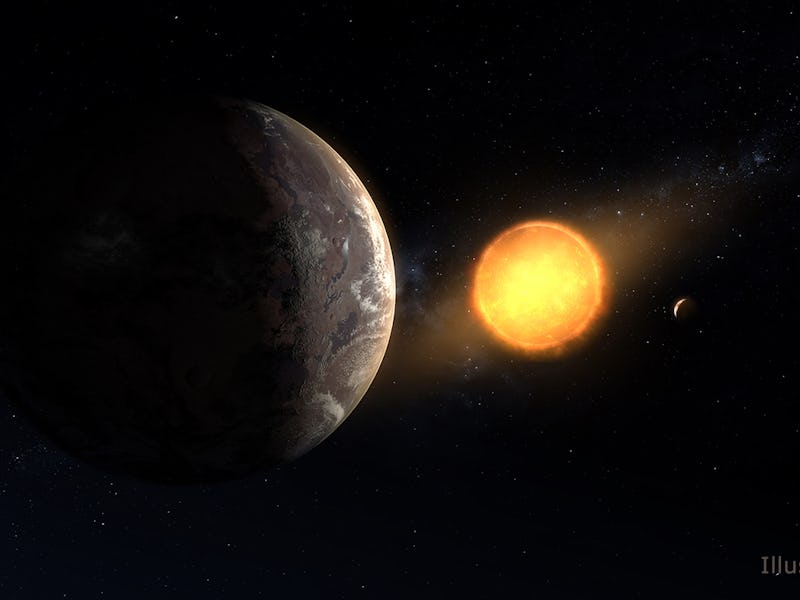Scientists discover a 'new Earth' after digging through data that A.I. missed
"We would have missed it," a scientist says about the habitability of Kepler-1649c.

In October 2018, NASA's Kepler space telescope ran out of fuel after nine years of surveying the wider cosmos, looking for alien worlds. During its mission, Kepler discovered more than 2,600 weird and exciting exoplanets.
Two years after retirement, Kepler is the mission that keeps on giving. Scientists re-examining old Kepler data have discovered an exoplanet that is the closest to Earth in terms of size and temperature and orbits within its star's habitable zone.
The discovery, announced this month, inches us closer to finding habitability outside of the Solar System.
The discovery was detailed in a paper published in the journal The Astrophysical Journal Letters.
The newly discovered exoplanet, dubbed Kepler-1649c, is about the same size as Earth, only 1.06 times larger than our own planet, and may have similar temperatures as it receives 75% of the amount of light that Earth receives from the Sun.
The newly discovered exoplanet shares some crucial similarities to our own planet.
Out of the approximately 4,000 exoplanets that we have discovered thus far, some have been closer to the size of Earth, while others had more similar temperatures. However, none have been this close to Earth in regards to both of those values, in addition to orbiting in its star's habitable zone, or the range of orbit around a star where a planet can support liquid water.
"A second Earth lies among the stars ... waiting to be found."
"This intriguing, distant world gives us even greater hope that a second Earth lies among the stars, waiting to be found," Thomas Zurbuchen, associate administrator of NASA's Science Mission Directorate in Washington, said in a statement.
Kepler-1649c is also relatively close, cosmically speaking, as it lies only 300 lightyears away from Earth.
Kepler-1649c is a whole new, possibly habitable world.
But before we pack our bags and head towards Kepler-1649c (metaphorically speaking of course, unless you got a wormhole handy), there are still a few things to consider.
Unlike Earth, Kepler-1649c orbits around a red dwarf star. Red dwarfs are the most populous stars in the galaxy, and yet they are also the smallest and coolest kind of stars with mass about 0.08 to 0.6 times that of the Sun. This type of star is also known for its stellar flare-ups, a sudden increase in a star's magnetic energy, which could make life on the exoplanet a bit challenging, according to NASA.
Scientists are also still unsure about the exoplanet's atmosphere, which could affect its temperatures and potential for hosting human life.
In addition to how closely the exoplanet orbits around its host star, which makes a year on Kepler-1649c equivalent to only 19.5 Earth days.
But there are other signs that indicate Kepler-1649c is a good candidate for habitability. The star system has another planet, a rocky planet of about the same size. However, this second planet orbits the star at about half the distance of Kepler-1649c.
The two planets follow a nearly perfect orbit-period ratios. So, for every four times the outer planet in the system orbits the host star, the inner planet orbits almost exactly nine times. This stable ratio is a sign that the system itself is stable and likely to survive for a long time, according to NASA.
A false positive — The Kepler mission, which launched in March 2009, looked for exoplanets through the transit method by observing stars and noting a dip in their brightness, which would indicate a planet is transiting around the star.
The Kepler mission surveyed the cosmos, looking for potentially habitable exoplanets.
However, the method is not always perfect, and sometimes another cosmic being cruising in front of the star, or variant changes in the star's brightness, could lead to a false positive.
In order to resolve that, the team of scientists behind the Kepler mission designed an algorithm, called Robovetter, to look through the data, and determine which of the brightness dips were likely exoplanets and which were false positives.
However, there was still a margin of error on part of the machine, therefore scientists had to double-check its work by going through each false positive and making sure it wasn't actually a planet.
More than six years after Kepler-1649c was labeled as a false positive, scientists uncovered this Earth-like world instead.
"We would have missed it."
"If we hadn't looked over the algorithm's work by hand, we would have missed it," Andrew Vanderburg, a researcher at the University of Texas at Austin and first author on the paper, said in a statement.
Not only does the new discovery place another exoplanet on the potentially habitable list, it also provides new evidence that red dwarf stars could host potentially habitable planets.
"The more data we get, the more signs we see pointing to the notion that potentially habitable and Earth-size exoplanets are common around these kinds of stars," Vanderburg said. "With red dwarfs almost everywhere around our galaxy, and these small, potentially habitable and rocky planets around them, the chance one of them isn't too different than our Earth looks a bit brighter."